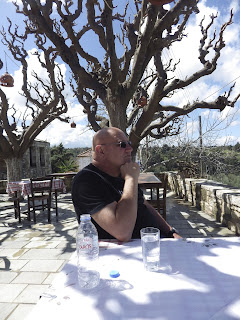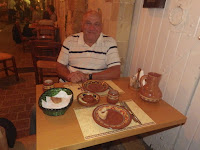 Spending exorbitant quantities of time in tavernas is one of the mainstays of life on Crete. This is real quality time for the most part and one of the aspects of life that attracts folks to live here.
Spending exorbitant quantities of time in tavernas is one of the mainstays of life on Crete. This is real quality time for the most part and one of the aspects of life that attracts folks to live here.
 Some have menus and some have chalk boards and in yet others the owner comes out a sits with you chatting about the village, getting to know you a little and explaining the menu. Below is one of our favourite places in the Akritiri where this owner comes a shares a genuine interest with each client.
Some have menus and some have chalk boards and in yet others the owner comes out a sits with you chatting about the village, getting to know you a little and explaining the menu. Below is one of our favourite places in the Akritiri where this owner comes a shares a genuine interest with each client.

It appears that every village, with the exception of ours, has at least one taverna where the people gather, especially later in the evening, to socialize, maybe eat, and certainly raise a glass of something- if only raki at the end of the evening.
Inevitably over the course of an evening you find yourselves chatting with those at neighbouring tables and make new friendships. On this evening we met Julie and Malcolm.



For the most part the tavernas are quite similar. The menus vary little. The wine is cold and cheap. The chairs are dreadfully uncomfortable. The hospitality is wonderful.
Outside of heavy tourist destinations and the main cities it seems hard to find a "poor" taverna. They survive because they are supported amidst countless other choices so they must be reasonably good to exist at all.
Here are stuffed zucchini flowers [right] served with taziki- a wonderful dish


In the main tourist areas tavernas regularly feature a poorer quality of food, much being frozen fast food, but even within these options exceptional traditional tavernas are to be found. The first clue is to look for where the Greeks eat of course, just like in Canada, when on a road trip we can count on a healthy meal if we stop where the long haul truckers stop.
Above is our friend Angelo at Kouvarus Taverna in Chania. Even when everyone else is empty there are usually some full tables here. That tells you all you need to know.
And you get known by these people. Nancy has a habit for dropping something sooner or later on herself. Angelo preempts it this time.

Some curious to us customs accompany taverna culture on Crete.
For example if you sit and order a cup of coffee you "own" that table until you choose to leave it and if that is 12 hrs later and you order nothing else, not a peep will be said.
Dirty food dishes will typically not be removed until you ask the staff to take them.
Here a large salade served in a delicious pastry bowl- it is a meal by itself and refreshing lunch on a hot day.

The taverna closes when you choose to go home. If you are known to the owners and it is exceptionally late, he/she may hand you the key and ask that you lock the door when you leave and put the key in X spot.
Mostly though at least one staff will simply sit and patiently wait until you are ready to go, and if you order more, it will come.
 When you are finally ready to leave there is one more tradition to be honoured, the "Gift of the House".
When you are finally ready to leave there is one more tradition to be honoured, the "Gift of the House".The staff will invite you remain a little longer and bring some small extra, maybe a plate of cut fruit or a honey cake, a jelly or some spoons sweets which regardless of the gift or the hour- will be accompanied by a bottle of ice cold raki.
Here is an example of the Gift of the House [right]

Passing a whole evening with generous amounts of food and drink will rarely result in a bill of over 25 euros [or $30 Cdn] per person.
Tourists typically get bills.

Traditional village tavernas where you are known will commonly conclude with the owner coming over, glancing at the table and stating some surprisingly low price for the pleasures of the evening.
Reading between the lines you may have concluded this also means that no taxes are collected on your meal either.

A long evening, again in a place where one is known, will see a litre or two of wine appear from time to time as a gift from the owner. "On the House". If the owner has something special in the kitchen it may appear "for you to try- no charge".

With music playing a Greek man, and sometimes a Greek woman, will stand and begin to dance. This is a private affair moving to they own steps and celebrating the goodness of life.
On New Years Eve day a woman in Chania dances beside her table. The steps are simple, often slow and methodical but intricate if you pay attention.


The Greeks love their fish and many tavernas specialize in fish and seafood.


One of favourite places to eat is in Perviolia: To Antikrysto. This means "opposite" and is a traditional Cretan way to cook meats with nothing else added but salts and slow heat allowing the fats to flow through, down and out.
Nikos is the owner/chef and has become a good friend having taken us under his wing so to speak when we rented a cottage beside his taverna a few years ago.
He takes great pride in his traditional food, and so he should as this taverna is truly exceptional on an island full of great places to eat.
Again he is one who comes and sits and explains his food and takes your order.
Guess what is in this fine package of hot Greek food- a hint- it is delicious and used to move on 4 feet.
His staff are fun and friendly.
He enjoys a 5 star rating on Trip Advisor which he has worked hard to earn.
This is a taverna that is out of the way in a working village and one that few tourists will find on their own. We take groups regularly to meet him, enjoy his food and promote his business with the ex-pat community.
To Ankikrysto is a vibrant place [ after 8 pm] full of Cretans who know quality and go for it.

Many tavernas feature little museums whether it is the old pistols on the walls or family pictures.
This hotel taverna is found in the village of Zaros high on the Dikteon Mountain.

If you ask the owner will surely introduce his whole family to you going back generations taking special pride in pointing out those who immagrated to Montreal or Toronto.
 It is not unusual to discover a taverna that also sells family produced products such as wine, raki, honey and more. These are often of the very best quality when found in the villages.
It is not unusual to discover a taverna that also sells family produced products such as wine, raki, honey and more. These are often of the very best quality when found in the villages.And who can go without Greek music and dancing to accompany the meal.

 This is not at every taverna nor is it every night but if music is your preferred choice it will not be hard to find. Some push back the tables after the many eating is concluded and then the dancing is on.
This is not at every taverna nor is it every night but if music is your preferred choice it will not be hard to find. Some push back the tables after the many eating is concluded and then the dancing is on.  Some tavernas become regular places in our routine. This taverna is in the mountain village of Vrisis where they make an exceptional BBQ chicken. We will go for Sunday lunch and sit by the stream with it's gentle waterfalls though the afternoon enjoying the peace of this gentle village- perhaps reading book or writing a blog post.
Some tavernas become regular places in our routine. This taverna is in the mountain village of Vrisis where they make an exceptional BBQ chicken. We will go for Sunday lunch and sit by the stream with it's gentle waterfalls though the afternoon enjoying the peace of this gentle village- perhaps reading book or writing a blog post.
As you can undoubtedly see taverna life is not difficult to adjust to.
One acquires the knack of resting and enjoying good food slowly quite easily on Crete.
This is called a gyros plate. It is fine shaved pork and chicken served on pita bread as a kind of open sandwich, with fries, salad and taziki. At plate of this is hard to finish as the portion sizes are very generous indeed.
my birthday
who can resist eating here?
 above is a shaded taverna near Falasarna, my favourite swimming beach. Here is an excellent place with great food to escape the heat for awhile in the height of the afternoon.
above is a shaded taverna near Falasarna, my favourite swimming beach. Here is an excellent place with great food to escape the heat for awhile in the height of the afternoon.
The tavernas are often simply yet tastefully decorated and each provides a number of features that entertain the eyes.
Taverna animals are another predictable feature of life on Crete. These animals are unowned but cared for in a shared way by the village as long as they are good. Scraps come their way and of course they keeps the ever present rodents away.

Pascha lamb cooking on Easter Eve at the break of the Lenten Fast after many Greeks have gone without meat or oil for several weeks. Here our family members Robert and Trish look at our evening meal being prepared in the village of Plaka.
At another taverna in Kissamos they say it all after a great meal by the ocean following a hard day at the beach.
 Taverna life can be challenging but we feel we have given it a good go and are well experienced and practiced so,when you are ready, we can introduce you to the rituals of taverna life on Crete.
Taverna life can be challenging but we feel we have given it a good go and are well experienced and practiced so,when you are ready, we can introduce you to the rituals of taverna life on Crete.
BTW- here is your answer to what was inside the beautiful package of food higher up. Lamb, feta and vegetables slow baked.
Thank you for reading my blog. I would appreciate comments, question should you have them and of course suggested corrections to any errors you feel I have made in substance or, ya I know, my less than perfect grammar.
































